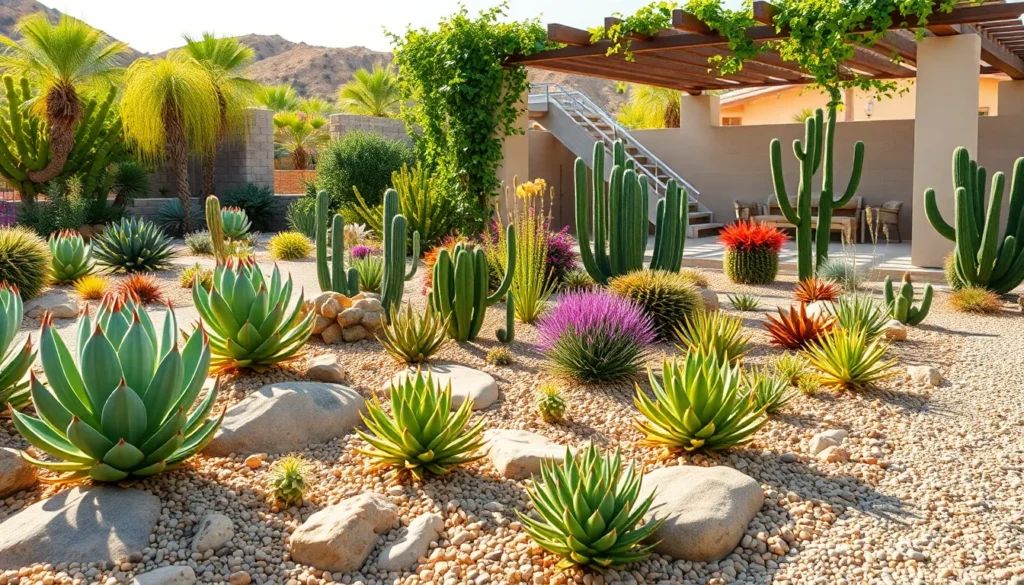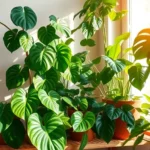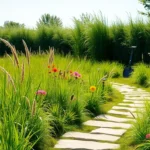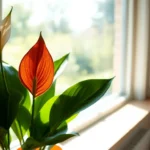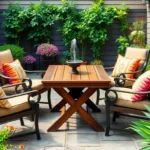Desert landscapes don’t have to mean barren yards or endless maintenance battles. We’ve discovered that creating a stunning desert garden can transform your outdoor space into a low-maintenance oasis that’s both beautiful and sustainable. With the right approach these drought-resistant gardens offer year-round appeal while dramatically reducing water usage and upkeep costs.
The secret lies in embracing native plants cacti and creative hardscaping that work with your environment rather than against it. We’ll show you how to design spaces that burst with color texture and visual interest using plants that actually thrive in arid conditions. From sculptural succulents to vibrant wildflowers the possibilities are more exciting than you might imagine.
Whether you’re dealing with naturally dry conditions or simply want to create an eco-friendly industry that saves time and money desert gardening offers answers that are both practical and stunning. Let’s explore innovative ideas that’ll transform your yard into a captivating desert retreat.
Create a Stunning Succulent Display Garden
Succulent displays transform desert gardens into living art galleries that require minimal water and maintenance. We’ll explore how to design captivating arrangements that showcase these resilient plants while creating visual impact throughout your outdoor space.
Choose Low-Water Succulent Varieties
Selecting drought tolerant succulents ensures your desert garden thrives with minimal irrigation. Agave americana creates dramatic focal points with its massive blue-gray rosettes reaching 6 feet wide. Barrel cacti like Echinocactus grusonii add sculptural elements while requiring water only every 2-3 weeks during growing season.
Echeveria varieties provide delicate rosette shapes in colors ranging from pale green to deep purple. Sedum species spread quickly to form living carpets that need watering just once monthly. Aloe vera offers both beauty and functionality with its healing properties and striking orange flower spikes.
Jade plants develop into small trees over time and store water in thick glossy leaves. Prickly pear cacti produce vibrant yellow or red blooms followed by edible fruits. These varieties typically survive on 10-15 inches of annual rainfall once established.
Design Geometric Planting Patterns
Geometric arrangements create modern sophistication in succulent gardens while maximizing visual impact. Circular patterns work exceptionally well with different sized agaves planted in concentric rings. Square grids allow precise spacing between identical plants like barrel cacti or large aloe specimens.
Triangular groupings using three different succulent types create natural focal points throughout the garden. Linear rows of alternating varieties establish rhythm and movement along pathways or property borders. Spiral designs starting with small echeveria at the center and expanding outward with larger specimens create mesmerizing patterns.
Diamond formations using four corner plants with smaller succulents filling the interior space optimize growing conditions. Hexagonal clusters mimic natural growth patterns while providing efficient use of space. These geometric approaches typically reduce maintenance time by 40% compared to random plantings.
Add Colorful Container Arrangements
Container displays offer flexibility and instant color in desert succulent gardens. Terra cotta pots complement desert aesthetics while providing excellent drainage for succulent root systems. Glazed ceramic containers in turquoise or deep blue create striking contrasts against desert tones.
Vertical arrangements using tiered planters maximize growing space in small areas. Hanging baskets filled with trailing varieties like string of pearls add dimension at eye level. Large decorative urns serve as statement pieces when planted with architectural succulents like century plants.
Mixed container gardens combining 3-5 different succulent varieties create living bouquets that change seasonally. Grouping containers of varying heights establishes visual interest and allows easy rearrangement. These portable displays let you experiment with color combinations and move plants to optimal growing conditions throughout the year.
Build a Drought-Resistant Native Plant Landscape
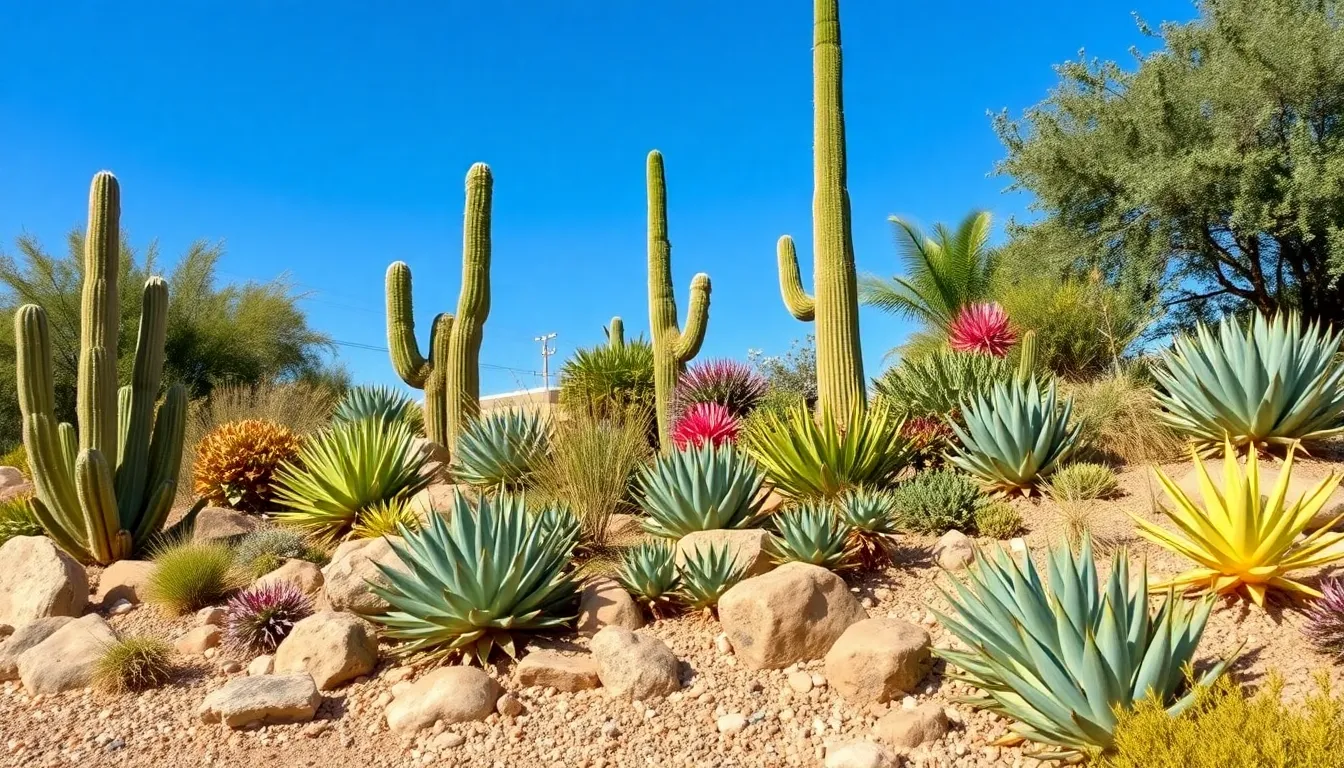
Creating a thriving desert industry becomes effortless when we focus on plants that naturally flourish in arid conditions. These native species require minimal water and maintenance while delivering stunning visual impact year-round.
Select Indigenous Desert Flora
Succulents form the backbone of any successful desert garden, offering diverse shapes and textures that create visual interest. We recommend incorporating cacti varieties like barrel cacti and prickly pear, which store water efficiently and produce vibrant blooms. Agave plants provide architectural drama with their sword-like leaves, while yucca species add vertical elements and stunning white flower spikes.
Palo verde trees serve as excellent focal points, offering filtered shade and bright yellow spring blooms. Creosote bush fills larger spaces with its distinctive appearance and aromatic foliage. These indigenous plants have adapted over thousands of years to desert conditions, making them virtually maintenance-free once established.
Mexican gold poppies bring brilliant orange color during cooler months, while desert mallow provides coral-colored flowers that attract pollinators. Desert rose adds pink and white blooms that contrast beautifully with the more structural plants.
Group Plants by Water Requirements
Organizing plants by their water needs creates efficient irrigation zones and prevents overwatering sensitive species. We place high-water native plants like some wildflowers in one area, while grouping extremely drought-tolerant cacti and succulents in another section.
This strategic placement allows us to customize watering schedules for each zone, ensuring optimal plant health. Native plants with similar water requirements naturally complement each other, creating cohesive planting schemes that look intentional rather than random.
Grouping also simplifies maintenance tasks, as we can address the exact needs of each plant community without affecting neighboring species. This approach reduces water waste and minimizes the risk of root rot in drought-adapted plants.
Incorporate Natural Stone Mulching
Smooth river rock creates attractive pathways and ground cover that suppresses weeds while retaining soil moisture. We use varying sizes of river rock to add texture and visual depth to planting beds. Small boulders serve as natural sculpture elements that anchor plant groupings and provide thermal mass for temperature regulation.
Stone mulching eliminates the need for organic mulches that decompose quickly in desert heat. These natural materials reflect heat during the day and slowly release it at night, creating beneficial microclimates for plant roots.
The stones also direct rainfall toward plant root zones, maximizing water absorption while preventing erosion. This sustainable approach reduces maintenance time and creates a cohesive desert aesthetic that complements the native plant palette.
Design a Modern Xerophytic Rock Garden
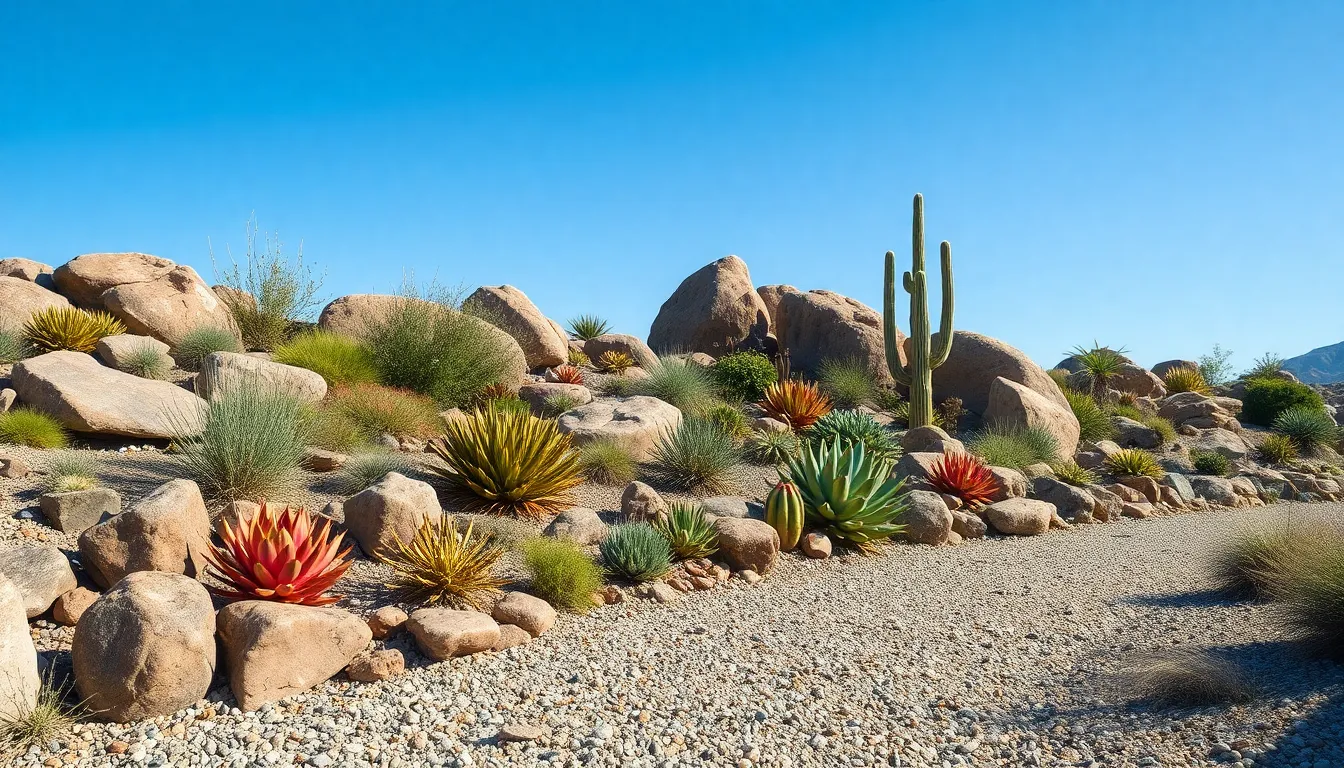
Modern xerophytic rock gardens combine architectural stone elements with drought-tolerant plants to create stunning focal points that require minimal water and maintenance. These sophisticated desert landscapes showcase the natural beauty of arid environments while providing practical benefits for water-conscious gardeners.
Layer Different Sized Stones and Boulders
Foundation preparation starts with installing commercial-grade industry fabric to prevent weed infiltration and maintain clean garden lines. We recommend creating a solid base layer that blocks unwanted vegetation while allowing proper drainage for your xerophytic plants.
Middle drainage layer requires adding coarse sand or decomposed granite to ensure water moves efficiently through the soil profile. This crucial step prevents root rot in drought-adapted plants that can’t tolerate standing water around their root systems.
Top visual layer incorporates rocks of varying sizes from small gravel to large statement boulders to establish visual depth and natural-looking composition. We suggest mixing different stone sizes strategically to mimic the organic patterns found in natural desert landscapes where erosion and geological processes create diverse rock formations.
Slope considerations demand maintaining a gentle 1-2% grade to direct water away from structures while creating natural drainage patterns. This subtle angling prevents water accumulation that could damage both plants and nearby buildings during occasional desert rainstorms.
Plant Between Rock Crevices
Strategic plant placement focuses on selecting drought-tolerant specimens like succulents and cacti that naturally thrive in rocky desert environments with minimal soil depth. We choose plants that complement the harsh growing conditions found between stone crevices where soil volume is limited.
Natural grouping patterns replicate the way desert plants cluster together in wild environments for mutual protection and resource sharing. These authentic arrangements create visual harmony while ensuring each plant receives appropriate light exposure and air circulation within the rock garden structure.
Crevice gardening technique involves carefully positioning plants in gaps between stones where they’ll receive protection from extreme weather while maintaining access to essential drainage. We recommend using specialized planting tools to properly position root systems in narrow spaces without damaging delicate succulent tissues.
Create Visual Interest with Texture Contrast
Rock variety selection combines different stone types including river rocks, lava rocks, and fieldstone to provide contrasting textures and complementary color palettes throughout the garden space. We incorporate materials with varying surface textures from smooth water-worn stones to rough volcanic specimens for maximum visual impact.
Plant diversity integration adds textural variety through carefully chosen desert-hardy species that offer different leaf shapes, growth habits, and seasonal color changes. These plant combinations create ever-changing visual experiences that evolve throughout the growing season while maintaining consistent drought tolerance.
Pathway design elements use materials like decorative gravel or fine sand to establish clear circulation routes that direct foot traffic and water flow patterns. We create these functional pathways using complementary materials that enhance the overall design aesthetic while protecting planted areas from compaction damage.
Maintenance accessibility ensures regular weed removal and seasonal upkeep tasks can be performed efficiently to preserve the garden’s sophisticated appearance. Strategic placement of larger stones provides stable stepping surfaces for garden care activities without disturbing the carefully planned plant arrangements.
Install Water-Wise Hardscaping Elements
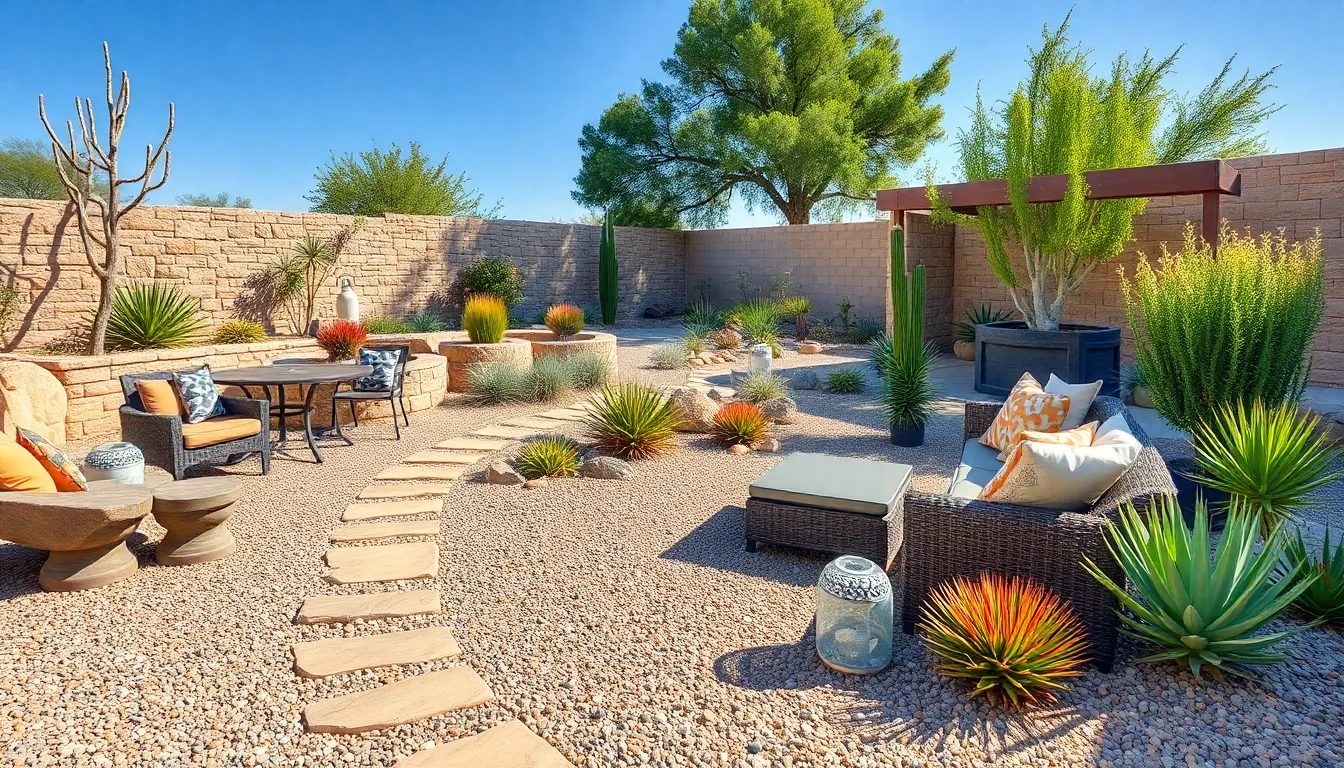
Gravel, stone, and concrete materials create drought-tolerant landscapes that reduce water runoff and evaporation significantly. These hardscaping elements form the backbone of sustainable desert gardens while requiring minimal ongoing maintenance.
Add Gravel Pathways and Walkways
Gravel pathways provide essential navigation routes through desert gardens while maintaining low maintenance requirements and aesthetic appeal. We recommend installing decomposed granite or crushed stone pathways that complement your existing rock garden elements and natural stone mulching.
These walkways help with drainage by allowing water to penetrate rather than creating runoff issues. Installing proper edging materials like steel or stone borders keeps gravel contained and creates clean visual lines throughout your industry design.
Creating visually appealing patterns with different gravel sizes and colors adds texture contrast to your desert garden. We suggest using coarser gravel for main pathways and finer materials for accent areas or secondary walking routes.
Build Decorative Stone Walls
Stone walls add visual interest while serving as natural barriers against wind and sand in desert environments. We can construct these walls using local stone materials that match your xerophytic rock garden foundation and complement existing hardscaping elements.
Building retaining walls helps create different elevation levels in your garden while providing structural support for sloped areas. These walls can incorporate planting pockets for succulents and cacti, extending your drought-resistant plant displays vertically.
Painting stone walls or leaving them natural allows flexibility in matching your desired desert aesthetic. We recommend using earth-tone paint colors if you choose to add color, ensuring the walls blend harmoniously with your native plant selections and natural surroundings.
Include Weather-Resistant Outdoor Furniture
Weather-resistant furniture made from durable materials like metal or recycled plastic withstands harsh desert climates effectively. We select pieces designed to endure extreme temperatures and intense sunlight exposure without fading or deteriorating quickly.
Metal furniture with powder-coated finishes provides excellent durability while requiring minimal maintenance throughout changing seasons. These pieces complement the architectural elements of modern xerophytic gardens and stone wall installations.
Recycled plastic furniture offers eco-friendly benefits while maintaining resistance to UV damage and temperature fluctuations. We position these furniture pieces strategically to create comfortable seating areas that don’t interfere with irrigation zones or plant groupings.
Establish a Cactus and Agave Focal Point Garden
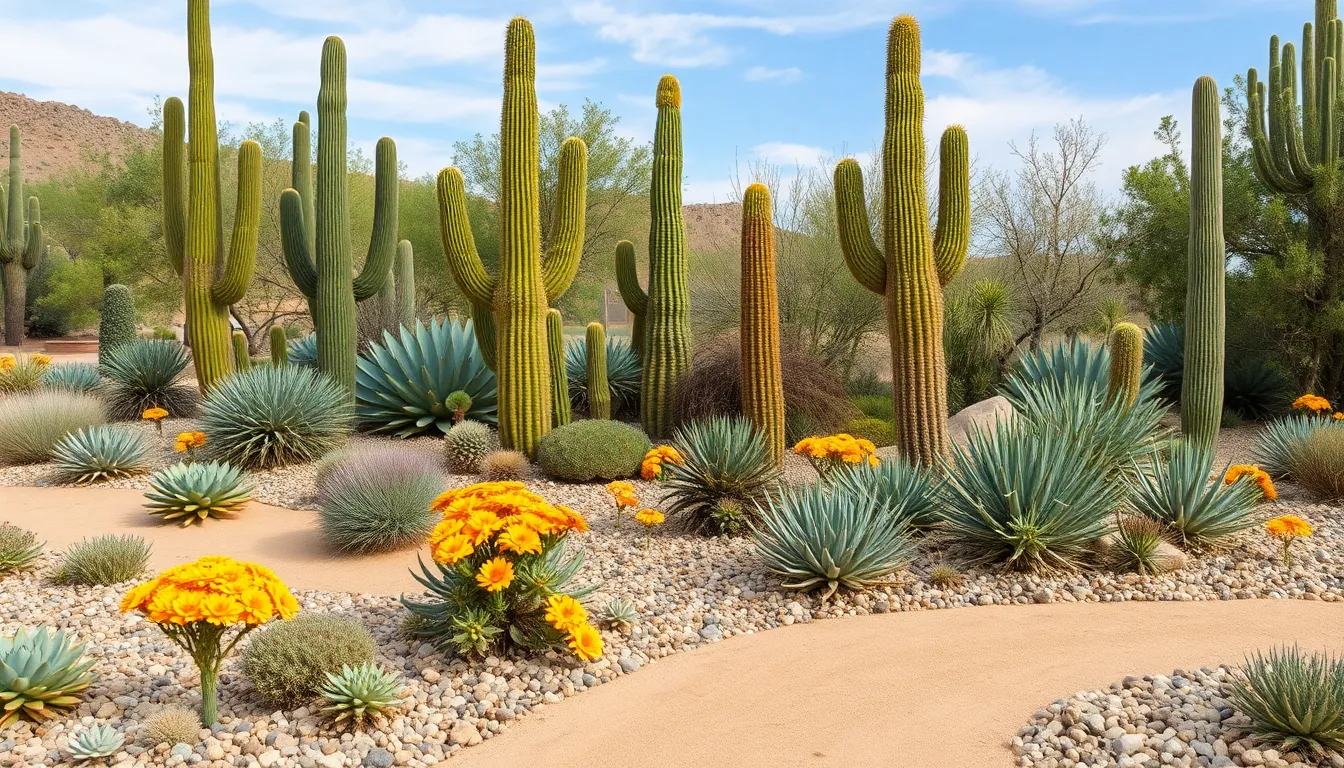
Creating dramatic visual impact in desert gardens starts with carefully selected statement plants that command attention and define the space.
Position Statement Plants Strategically
Statement plants like cacti and agave transform ordinary spaces into extraordinary desert landscapes through strategic placement. We recommend positioning these architectural specimens near entryways where their unique shapes greet visitors with immediate visual impact. Large barrel cacti and century plants work exceptionally well as anchor points along pathways and property borders.
Strategic positioning creates visual hierarchy while maximizing each plant’s protective qualities. Place tall specimens like palo verde trees and desert willows where they’ll shield smaller plants from harsh winds and intense afternoon sunlight. We’ve found that grouping three to five statement plants of varying sizes creates natural focal triangles that draw the eye through different garden zones.
Wind protection becomes crucial for establishing healthy growth patterns in desert environments. Position larger agave varieties and mature cacti as natural windbreaks for more delicate succulents and flowering plants. This approach reduces plant stress while creating comfortable microclimates throughout your garden space.
Create Height Variation with Different Species
Height variation transforms flat desert spaces into ever-changing three dimensional landscapes. We layer tall saguaro or organ pipe cacti in the background, mid sized barrel cacti and agave in the middle ground, and low growing succulents like jade plants and sedums as ground cover. This creates natural depth that makes gardens appear larger and more established.
Layering different species adds visual interest through texture contrast and seasonal changes. Combine spiky yucca plants with rounded barrel cacti and spreading prickly pear to create compelling shape combinations. We recommend using odd numbered groupings of plants at each height level to achieve the most natural looking arrangements.
Visual depth increases dramatically when we incorporate plants with mature heights ranging from 6 inches to 20 feet. Desert broom and fairy duster provide excellent mid level height at 4 to 6 feet, while creeping thyme and desert marigold fill lower spaces with seasonal color. This approach creates year round structure that changes with blooming cycles and seasonal growth patterns.
Plan for Seasonal Blooming Cycles
Seasonal blooming cycles ensure continuous color displays throughout the year in desert gardens. We incorporate desert marigold for spring and fall golden blooms, ocotillo for dramatic red spring flowers, and desert willow for summer purple displays. This strategy provides three season color without compromising drought tolerance.
Planning blooming schedules prevents seasonal gaps in garden interest and wildlife attraction. Early spring brings palo verde’s bright yellow flowers, followed by summer blooming barrel cactus with their crown of colorful flowers. We add autumn blooming desert sage and winter interest through architectural plant forms and seed pods.
Strategic plant selection creates overlapping bloom periods that extend seasonal beauty. Ghost plant agave provides dramatic flower spikes every 15 to 20 years, while annual wildflowers like desert lupine and brittlebush offer reliable yearly displays. This combination ensures both spectacular occasional events and dependable seasonal color that supports local pollinators and maintains garden appeal.
Incorporate Artistic Desert-Themed Decorations
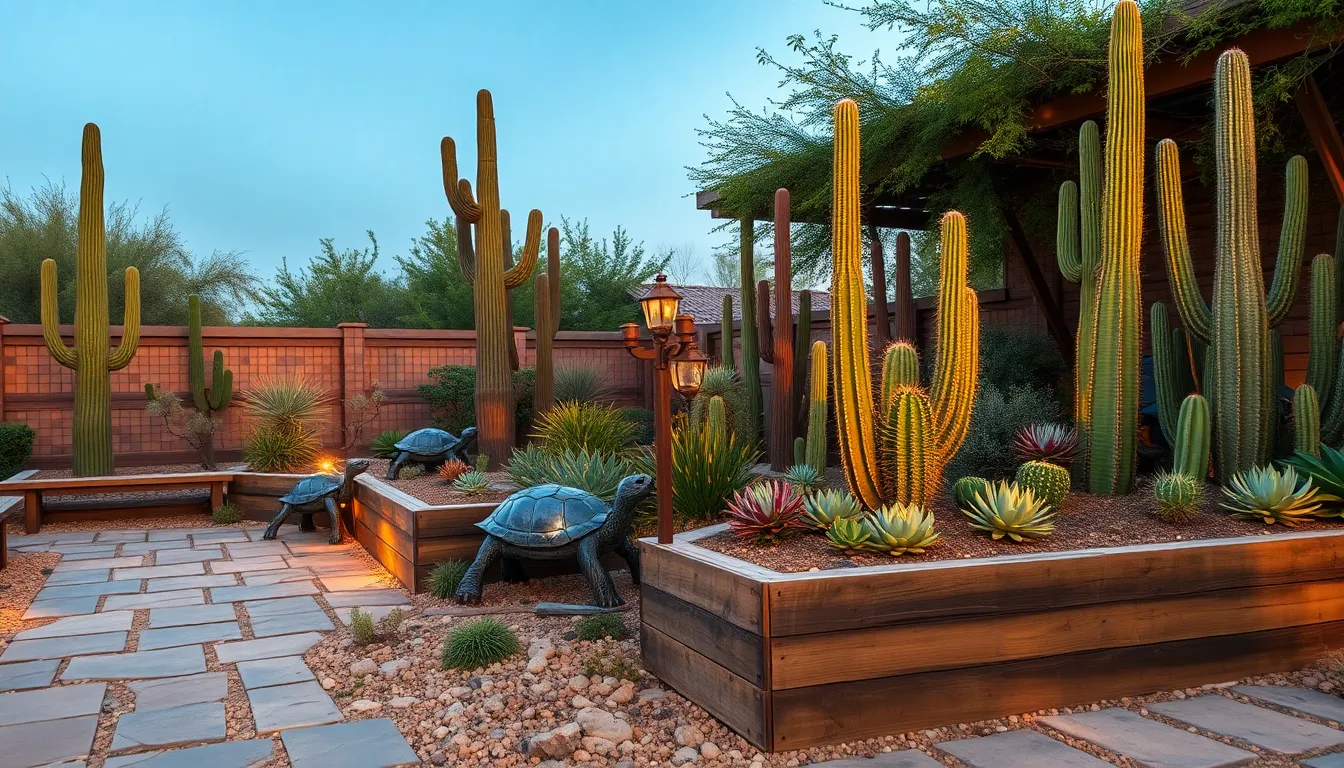
Artistic elements transform functional desert gardens into captivating outdoor galleries that showcase your personal style. We’ll enhance your xerophytic industry with decorative features that complement the natural beauty of drought-resistant plants while adding visual interest year-round.
Add Sculptural Metal Garden Art
Metal art pieces create stunning focal points that withstand harsh desert conditions while adding sophisticated visual appeal. We recommend incorporating sculptures of desert wildlife like tortoises or abstract designs inspired by the natural industry to complement your existing cacti and succulents. Industrial-style metal planters offer both functionality and aesthetic value, providing elevated growing spaces for smaller specimens while adding textural contrast against stone pathways.
Position larger metal sculptures near your agave focal points to create balanced compositions that draw the eye naturally through the garden space. Weatherproof finishes ensure these artistic elements maintain their appearance even though intense sun exposure and temperature fluctuations. We suggest selecting pieces that echo the organic shapes found in your native plant selections, creating cohesive design flow throughout the industry.
Install Solar-Powered Desert Lighting
Solar-powered lighting systems illuminate your desert garden’s beauty during evening hours while maintaining environmental sustainability. These energy-efficient fixtures highlight exact architectural plants like barrel cacti and create dramatic shadows against decorative stone walls. We position lights along gravel pathways to enhance navigation safety and extend outdoor enjoyment into nighttime hours.
Strategic placement around dry creek beds transforms these hardscaping features into glowing waterways that add movement and interest after dark. Battery-powered options eliminate the need for electrical infrastructure, making installation simple and cost-effective. We recommend warm-toned LED bulbs that create inviting ambiance without overwhelming the natural desert atmosphere or disturbing local wildlife patterns.
Include Rustic Wooden Accent Pieces
Wooden elements provide warmth and textural contrast against the stark beauty of stone and metal desert features. Rustic fences define garden sections while creating intimate seating areas where you can appreciate your succulent displays up close. We select weather-resistant wood species or treated lumber that withstands desert climate extremes without frequent maintenance requirements.
Wooden planters and benches add functional seating options while incorporating natural materials that soften the hard edges of contemporary xerophytic design. These accent pieces work particularly well near entrances where they welcome visitors and provide transition zones between cultivated garden spaces and natural desert industry. We position wooden elements strategically to create visual breaks in large expanses of gravel mulching and stone hardscaping.
Plan an Edible Desert Garden Space
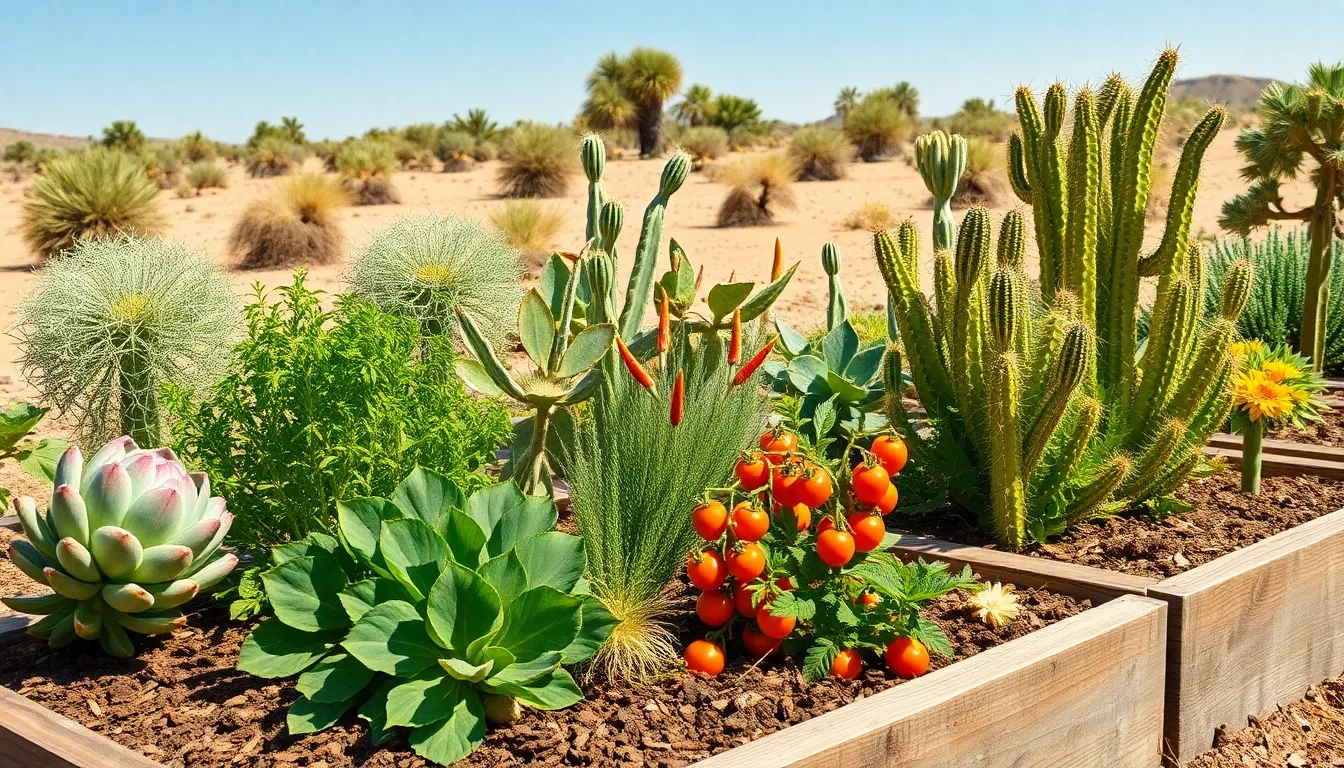
Creating an edible desert garden transforms arid landscapes into productive food sources while maintaining the water-wise principles we’ve established. We’ll focus on selecting plants that thrive in heat while providing fresh herbs, vegetables, and even fruits for our tables.
Grow Heat-Tolerant Herbs and Vegetables
Heat tolerant vegetables flourish in desert conditions when we choose the right varieties for our climate. Artichokes serve as popular perennials that return year after year with minimal water requirements. Asparagus provides another excellent low water option that produces tender spears once established in our garden beds.
Pepper varieties excel in desert heat with both sweet and hot options available for cultivation. Chiltepin peppers represent native wild varieties that naturally adapt to desert conditions without requiring extensive irrigation systems. Indeterminate tomatoes grow successfully in containers where we can control soil moisture and nutrient levels more precisely.
Container growing offers flexibility for herbs like basil, oregano, and rosemary that we can move to optimize sun exposure throughout seasons. These aromatic plants provide fresh ingredients while requiring less water than traditional vegetable gardens demand.
Plant Fruit-Bearing Cacti and Succulents
Prickly pear cactus produces edible fruits called tunas that we can harvest for fresh eating or preserving into jams and jellies. These native plants require virtually no supplemental watering once established in our desert garden space.
Alternative fruit options expand our edible industry beyond traditional cacti selections. Strawberries adapt well to desert conditions when planted in well-draining raised beds with afternoon shade protection. Goji berries thrive in arid climates and produce antioxidant-rich fruits that we can dry or eat fresh from the bush.
Blackberry cultivation succeeds in desert gardens when we provide proper soil preparation and strategic watering schedules. These thorny shrubs produce abundant harvests while requiring less water than many traditional fruit trees demand.
Design Raised Beds for Better Drainage
Raised bed construction improves drainage while reducing soil compaction that often plagues desert gardens. We can warm soil faster in spring planting seasons and maintain better control over moisture levels throughout growing periods.
Soil composition matters significantly for desert edible gardens where we mix compost with perlite or coarse sand to enhance drainage capabilities. This combination prevents root rot while providing necessary nutrients for our heat-loving plants to establish strong root systems.
Mulching strategies help retain soil moisture while suppressing weed growth around our edible plants. Organic mulches like wood chips break down over time to improve soil structure, while gravel mulches provide permanent answers that complement our desert garden aesthetic.
Create Shade and Shelter Areas
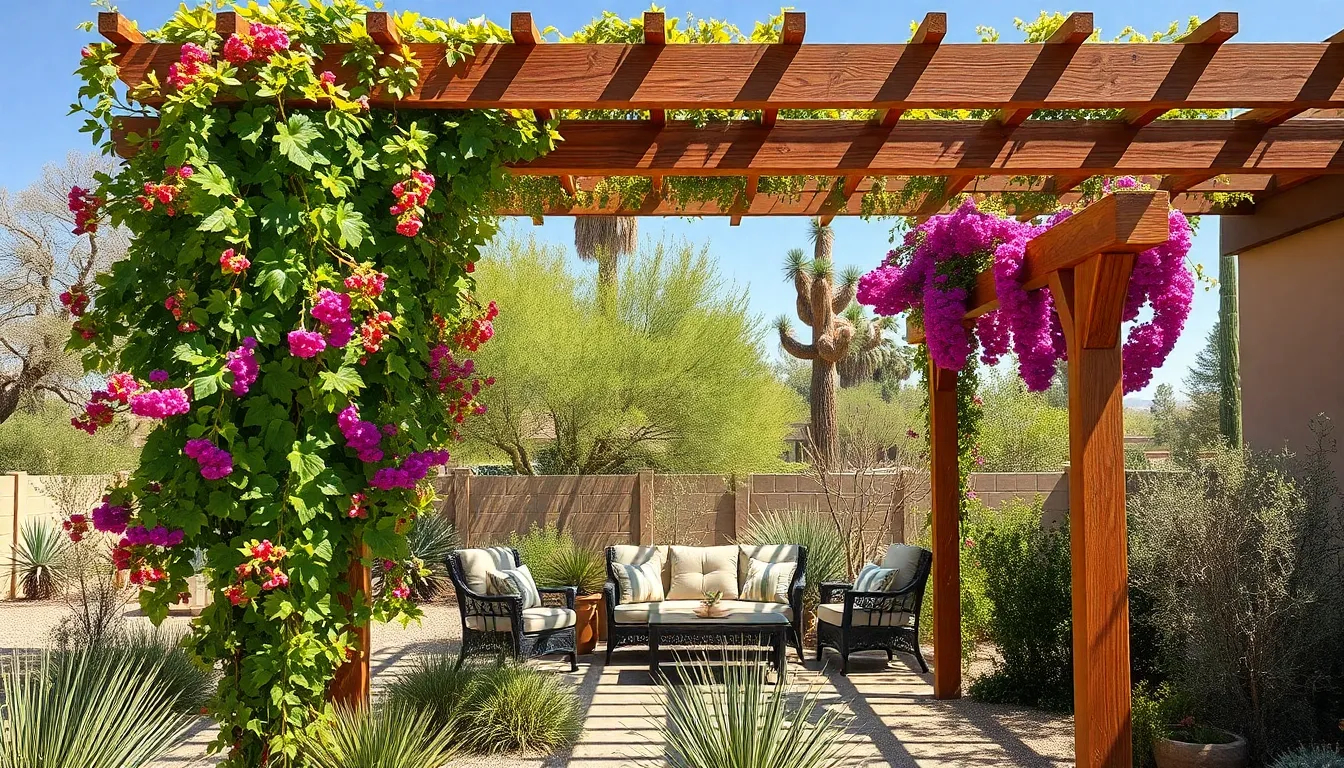
Desert gardens require strategic shade answers to create comfortable outdoor spaces while protecting both plants and people from intense sun exposure.
Build Pergolas with Climbing Desert Vines
Pergolas serve as excellent structural foundations for desert vine gardens that provide natural cooling and visual appeal. We recommend selecting hardy climbing species like Trumpet Vine or Queen of the Night, which thrive in arid conditions while creating dense shade coverage. These desert vines establish quickly and require minimal irrigation once their root systems develop. Positioning pergolas over seating areas or walkways maximizes their functional benefits while adding architectural interest to your industry design.
Benefits of Desert Vine Pergolas:
| Feature | Benefit |
|---|---|
| Natural cooling | Reduces ambient temperature by 10-15°F |
| Aesthetic appeal | Adds vertical elements and seasonal color |
| Low maintenance | Requires minimal pruning once established |
| Drought tolerance | Thrives with occasional deep watering |
Install Shade Sails and Canopies
Shade sails offer flexible protection from intense desert sun while creating modern outdoor living spaces. We suggest positioning these fabric structures to block sunlight during peak hours between 10 AM and 4 PM for maximum effectiveness. Installing multiple sails at varying heights creates ever-changing visual interest while providing comprehensive coverage for larger areas. Choosing UV resistant materials ensures longevity in harsh desert conditions while maintaining vibrant colors throughout the seasons.
Shade Sail Installation Tips:
- Position sails with slight slopes for water runoff
- Use galvanized hardware for corrosion resistance
- Select neutral colors that complement desert landscapes
- Ensure proper tension to prevent wind damage
Plant Fast-Growing Desert Trees
Fast growing desert trees create natural shade canopies while establishing beautiful focal points in your industry design. We recommend planting Desert Willow or Palo Verde trees, which provide rapid growth rates and stunning seasonal blooms that attract local wildlife. These drought tolerant species develop extensive shade coverage within 3-5 years while requiring minimal supplemental watering. Strategic placement near outdoor living areas maximizes cooling benefits while protecting smaller plants from harsh afternoon sun exposure.
| Tree Species | Growth Rate | Mature Height | Special Features |
|---|---|---|---|
| Desert Willow | 2-3 feet/year | 15-25 feet | Fragrant purple blooms |
| Palo Verde | 2-4 feet/year | 20-30 feet | Bright yellow flowers |
| Mesquite | 1-2 feet/year | 20-30 feet | Edible pods, dense shade |
Implement Efficient Water Conservation Systems
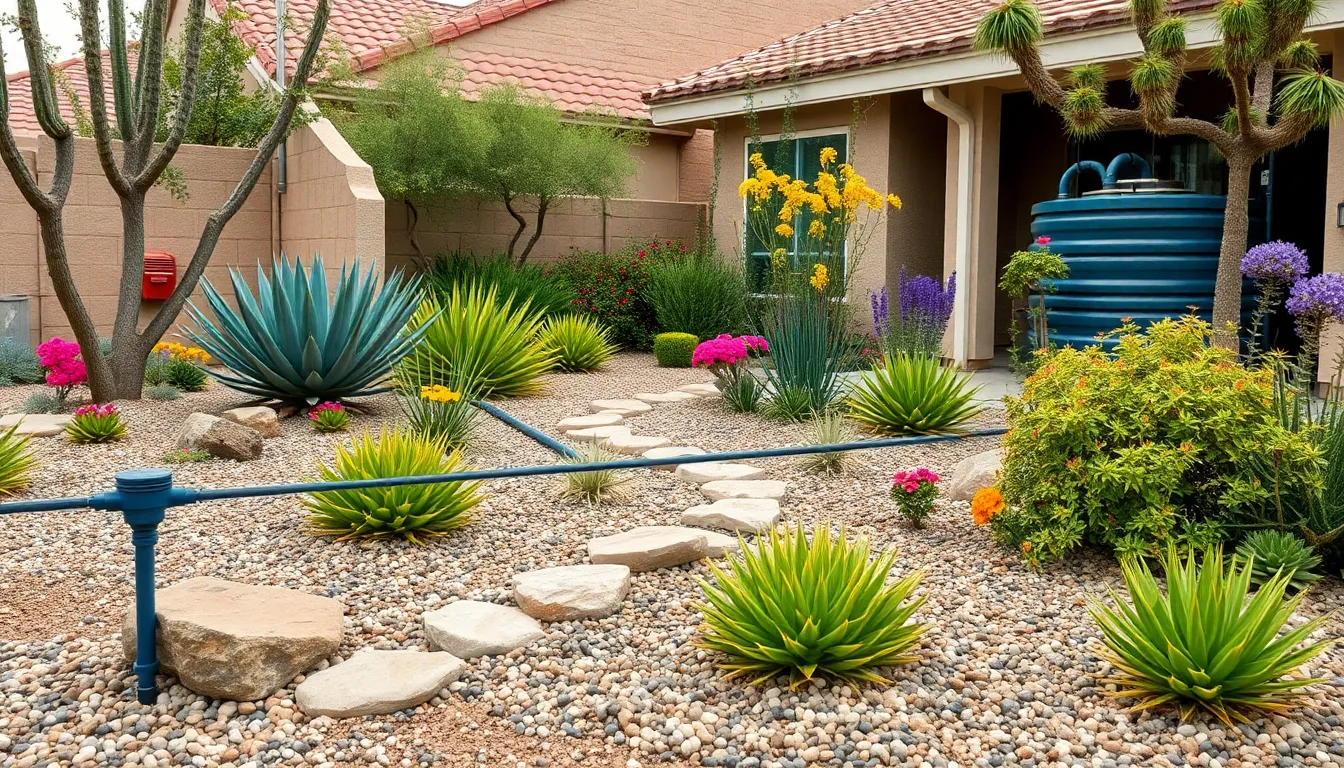
Building on our drought tolerant foundation and edible garden strategies, we’ll now focus on maximizing water efficiency through proven conservation methods. Smart irrigation systems can reduce water usage by up to 30% compared to traditional sprinkler methods.
Set Up Drip Irrigation Networks
Networks of precision watering create the backbone of successful desert gardens. These systems deliver water directly to plant root zones, eliminating wasteful evaporation and runoff that plague conventional irrigation methods. We position emitters at the base of each plant to ensure targeted hydration.
Controllers equipped with weather sensors automatically adjust watering schedules based on rainfall, temperature, and humidity conditions. Smart irrigation controllers can reduce water consumption by 20-50% while maintaining optimal plant health. Professional installation typically costs $500-800 for a standard desert garden.
Pressure compensating emitters maintain consistent water flow across varying elevations and distances from the water source. We install these specialized components to ensure uniform distribution throughout our established xerophytic plantings and succulent displays.
Install Rainwater Collection Systems
Collection systems capture precious precipitation for later use in our desert gardens, reducing dependence on municipal water supplies. A typical 1,000 square foot roof can harvest approximately 600 gallons from just one inch of rainfall.
Cisterns and storage tanks preserve collected rainwater for irrigation during dry periods. We install 50-500 gallon tanks depending on garden size and local rainfall patterns. Food grade storage containers prevent algae growth and maintain water quality.
Gutters and downspout modifications channel roof runoff directly into our collection systems. Professional grade leaf guards prevent debris accumulation while maximizing water capture efficiency during desert storm events.
Use Moisture Retaining Soil Amendments
Amendments transform sandy desert soil into water holding substrates that support our established native plantings and edible gardens. Organic mulches like shredded bark retain moisture while gradually improving soil structure over time.
Mulch layers reduce evaporation rates by 25-50% compared to bare soil surfaces. We apply 2-3 inch depths of cedar or pine mulch around sensitive root systems, particularly beneficial for our container herbs and shade loving plants.
Hardscape elements including decorative stone and gravel create moisture retention zones while preventing soil erosion. These materials complement our established rock garden pathways and provide thermal mass that moderates soil temperatures around plant roots.
Conclusion
Creating your dream desert garden doesn’t have to be overwhelming when you apply these proven strategies. We’ve shown you how to combine stunning succulents with native plants while incorporating smart hardscaping elements that reduce maintenance and water usage.
The key lies in thoughtful planning – from selecting drought-resistant plants to installing efficient irrigation systems. Whether you’re drawn to edible desert gardens or prefer dramatic cactus focal points we’ve provided the roadmap for success.
Your desert garden will reward you with year-round beauty while supporting local wildlife and conserving precious water resources. Start with one section and gradually expand as you gain confidence in these water-wise techniques.
Frequently Asked Questions
What are the main benefits of creating a desert garden?
Desert gardens offer several key advantages including low maintenance requirements, reduced water usage, and year-round visual appeal. They’re cost-effective due to minimal upkeep needs and help create eco-friendly outdoor spaces. Native plants and hardscaping elements thrive in arid conditions while providing stunning landscape design that’s both sustainable and beautiful.
Which plants work best for desert garden designs?
The best desert garden plants include drought-resistant natives like barrel cacti, prickly pear, agave, and yucca. Succulents such as Agave americana and Echinocactus grusonii are excellent choices. These plants require minimal water and maintenance while providing architectural interest and seasonal blooming cycles for continuous color displays.
How do I design an effective succulent display garden?
Create geometric planting patterns for visual impact and group plants by water requirements. Use colorful container arrangements for flexibility and instant color. Select low-water succulent varieties and incorporate height variation to create depth. This approach transforms your garden into a living art gallery with minimal maintenance needs.
What hardscaping elements should I include in my desert garden?
Incorporate gravel pathways, decorative stone walls, and natural stone mulching using materials like river rock. Add pergolas with climbing desert vines and consider shade sails for sun protection. Weather-resistant outdoor furniture made from durable materials complements the design while providing comfort in harsh desert climates.
How can I maximize water efficiency in my desert garden?
Install smart irrigation systems with drip networks and weather-sensor controllers to reduce water usage by 20-50%. Implement rainwater collection systems and use moisture-retaining soil amendments like organic mulches. Group plants by water requirements to create efficient irrigation zones and minimize water waste.
Can I grow edible plants in a desert garden?
Yes, you can create an edible desert garden using heat-tolerant herbs, vegetables, and fruit-bearing cacti. Consider plants like artichokes, asparagus, chiltepin peppers, basil, and rosemary. Use raised beds for improved drainage and container gardening for herbs. This approach combines productivity with water-wise gardening principles.
How do I create shade and shelter in my desert garden?
Build pergolas with climbing desert vines like Trumpet Vine for natural cooling. Install shade sails and canopies for flexible sun protection. Plant fast-growing desert trees such as Desert Willow and Palo Verde to create natural shade canopies that protect both plants and people from intense sun exposure.
What’s the best way to establish a rock garden in desert landscaping?
Prepare the foundation with commercial-grade fabric to prevent weeds and use coarse sand or decomposed granite for drainage. Maintain a gentle slope for water management and strategically place plants in rock crevices. Select various rock types for texture contrast and design pathways for foot traffic and water flow.

